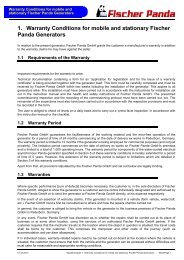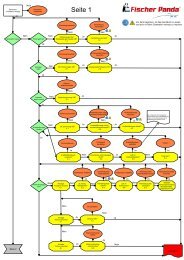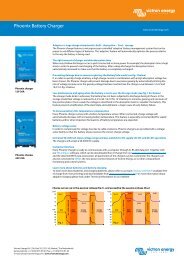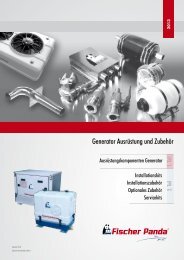Victron "Energy Unlimited" - Utu
Victron "Energy Unlimited" - Utu
Victron "Energy Unlimited" - Utu
You also want an ePaper? Increase the reach of your titles
YUMPU automatically turns print PDFs into web optimized ePapers that Google loves.
2. The battery: preventing premature aging<br />
2.1. Introduction<br />
I like engines. When they go wrong you can listen, and look, and smell, and then take them apart. Parts can be replaced,<br />
repaired or overhauled. Then put it all together again, and there they go!<br />
With a battery you can’t do that. The battery is a secretive product. From the outside there is nothing to tell us about its<br />
quality, possible aging or state of charge. Nor is it possible to take it apart. It could be sawn open, but that ruins it for<br />
good and only highly qualified specialists could analyse the content and may be, in certain cases, they could trace the<br />
cause of failure.<br />
A battery, when it fails, has to be replaced. That’s it.<br />
A battery is expensive, bulky and very very heavy. Just think: with 10 litres of diesel (= 8.4 kg) and a diesel generator you<br />
can charge a battery of 24 V 700 Ah (energy content 24 x 700 = 16.8 kWh). Such a battery has a volume of 300 dm 3<br />
(= 300 litres) and weighs 670 kg!<br />
Also, batteries are very vulnerable. Overcharging, undercharging, discharging too deeply, charging too fast, excessive<br />
temperature…. All these issues can occur and the consequences can be disastrous.<br />
The purpose of this chapter is to explain why batteries fail, and what to do to make them last longer. And if you want to<br />
have a look inside a faulty battery, don’t open it yourself. It is extremely dirty work and for the price of a new pair of<br />
trousers (the sulphuric acid of the battery will ruin them) buy the standard work of Nigel Calder, “Boatowner’s Mechanical<br />
and Electrical Manual”, and enjoy the many close-up’s of failed batteries in chapter 1.<br />
2.2. Battery chemistry<br />
2.2.1. What happens in a cell as it discharges<br />
As a cell discharges lead sulphate forms on both the positive and negative plates through absorption of acid from the<br />
electrolyte. The quantity of electrolyte in the cells remains unchanged. However, the acid content in the<br />
electrolyte reduces, something noticeable in the change of the specific gravity.<br />
2.2.2. What happens during charging<br />
During charging the process is reversed. On both plates acid is released, while the positive plate converts into lead oxide<br />
and the negative plate into porous, sponge-like lead. Once charged the battery can no longer take up energy, and any<br />
further energy added is used to decompose water into hydrogen gas and oxygen gas.<br />
This is an extremely explosive mixture and explains why the presence of an open flame or sparks in the vicinity of a<br />
battery during charging can be very hazardous. It is therefore necessary to ensure that a battery compartment has<br />
effective ventilation.<br />
2.2.3. The diffusion process<br />
When a battery is being discharged, ions have to move through the electrolyte and through the active material of the<br />
plates to come into contact with the lead and lead oxide that has not yet been chemically converted into lead sulphate.<br />
This moving of ions through the electrolyte is called diffusion. When the battery is being charged the reverse process<br />
takes place. The diffusion process is relatively slow, and as you can imagine, the chemical reaction will first take place at<br />
the surface of the plates, and later (and also slower) deep inside the active material of the plates.<br />
2.2.4. Service life<br />
Depending on construction and use, the service life of a battery ranges from a few years to up to 10 years or more. The<br />
main reasons for batteries to age are:<br />
- Shedding of the active material. Intensive cycling (= discharging and recharging a battery) is the main<br />
reason for this to happen. The effect of repetitive chemical transformation of the active material in the plate grid<br />
tends to reduce cohesion, and the active material falls of the plates and sinks to the bottom of the battery.<br />
- Corrosion of the positive plate grid. This happens when a battery is being charged, especially at the end of the<br />
charge cycle when the voltage is high. It also is a slow but continuous process when a battery is float charged.<br />
Oxidation will increase internal resistance and, finally, result in disintegration of the positive plates.<br />
<strong>Victron</strong> <strong>Energy</strong> BV ©<br />
11

















